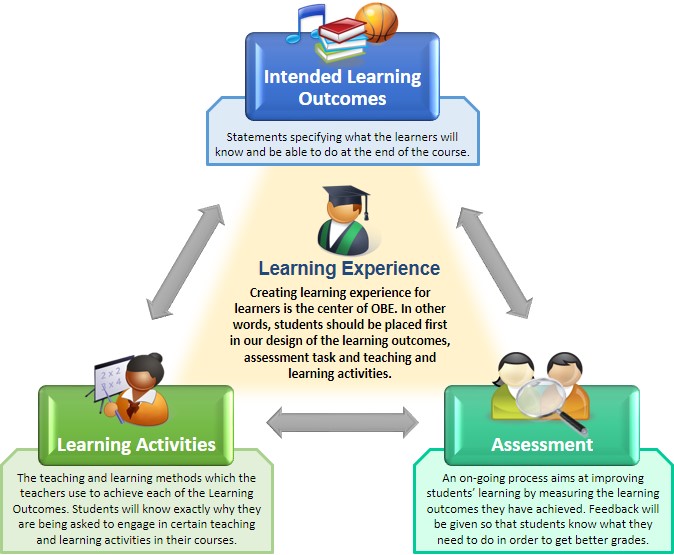Learner-Centered Course Design
What is learner-centered course design?
The term learner-centered is akin to “user-centered” focus of a product. If a course is designed in a learner-centered way, it means extensive attention has been given to the needs, interest and skills of our learners when we design our course. As oppose to content-centered course design, where teacher usually works up a list of topic and decides how much time to spend on each, the heart of learner-centered approach is to decide first what students can and should learn in relation to this course, then how to assess students’ performance and figured out how such learning can be facilitated. By shifting from content-centered to learner-centered, instructional design becomes learning experience design.
Outcome-based education (OBE)
Outcome-based education (OBE) is a learner-centered learning philosophy that focuses on measuring students’ performance (the outcomes). OBE itself is not a teaching style or method, it is a principle for designing your teaching in an effective way that enables learning happen and helps students to achieve the intended learning outcomes. Therefore, what matters most in OBE is “what is learnt” rather than “what is taught”.
OBE Principles
There are different definitions for outcome-based education. The most widely used one is the four principles suggested by Spady (1994).
An OBE curriculum means starting with a clear picture of what is important for students to be able to do, then organizing the curriculum, instruction and assessment to make sure this learning ultimately happens. The four basic principles are (Spady, 1994):
- Clarity of focus
This means that everything teachers do must be clearly focused on what they want students to know, understand and be able to do. In other words, teachers should focus on helping students to develop the knowledge, skills and personalities that will enable them to achieve the intended outcomes that have been clearly articulated.
- Designing down
It means that the curriculum design must start with a clear definition of the intended outcomes that students are to achieve by the end of the program. Once this has been done, all instructional decisions are then made to ensure achieve this desired end result.
- High expectations
It means that teachers should establish high, challenging standards of performance in order to encourage students to engage deeply in what they are learning. Helping students to achieve high standards is linked very closely with the idea that successful learning promotes more successful learning.
- Expanded opportunities
Teachers must strive to provide expanded opportunities for all students. This principle is based on the idea that not all learners can learn the same thing in the same way and in the same time. However, most students can achieve high standards if they are given appropriate opportunities.
Model of OBE & its features

Backward design
When designing our courses, it is suggested that we adopt the backward design approach. Grant Wiggins and Jay McTighe provides an innovative approach for designing courses through what they call “Backward Design”. They argue that you can’t start planning how you’re going to teach until you know exactly what you want your students to learn. In other words, “Backward Design” means we start with the desired results of our teaching and leave teaching activities until the end.

Stages of the Backward Design process:
- Stage one: Identify desired results
Before we design any teaching activities or assessment tasks, first we need to establish the learning goals for the course. Learning goals are the things that we want students to know, understand and be able to do at the end of the course. To help faculty identifying the learning goals, the following questions suggested by Wiggins and McTighe may come in handy:- What should participants hear, read, view, explore or otherwise encounter? This knowledge is “worth being familiar with.”
- What knowledge and skills should participants master? Sharpen your choices by considering what is “important to know and do” for your students. What facts, concepts and principles should they know? What processes, strategies and methods should they learn to use?
- What are big ideas and important understandings participants should retain? These choices are the “enduring understandings” that you want students to remember after they’ve forgotten the details of the course.
Answering each of these questions will help you determine the best content for your course, and create concrete, specific learning goals for your students.
- Stage two: Determine acceptable evidence
In the second phase of Backward Design, faculty need to think about the acceptable evidence that shows students are making progress toward the learning goals of the course. We need to plan how we will collect the evidence (through a wide range of assessment methods) to ensure that our assessment matches with the learning goals we set in stage one.
- Stage three: Plan learning experiences
Finally, after we have identified and decided what results we want and how we will know our students have achieved them, then we need to start planning how we are going to teach. In stage three, the focus is more on instructional strategies and students’ learning activities but the center of both is creating or designing learning experience for our students.
References:
Spady, W. 1994. Outcomes Based Education: Critical Issues and Answers. American Association of School Administration: Arlington, Virginia.
Wiggins, G., & McTighe, J. (2005). Understanding by design. (2nd Edition). Alexandria, VA: Association for Supervision and Curriculum Development.
Fink, L. D. (2013) Creating Significant Learning Experiences, An Integrated Approach to Design College Courses, Jossey Bass
- 22868 reads
